United States Mint

 Producer of many pre-1933 gold coins and the contemporary American Eagles
Producer of many pre-1933 gold coins and the contemporary American Eagles
The US Mint is the official mint of the government of the United States. It produces the country's coins (official circulating coins as well as investment bullion coins and numismatic/commemorative coins) as well as coins for foreign countries. Its gold, silver and platinum coins are highly valued by both investors and collectors. In addition to the mint's current ongoing production of contemporary bullion coins, many coins that it had produced in the past are still actively traded by professional gold dealers as well as individual investors and collectors throughout the world. These pre-1933 U.S. gold coins like the Saint Gaudens Double Eagles had been minted by the various branches of the US Mint in the millions back then. The United States Mint also produces collectible commemorative coins (including special coins to mark anniversary years) as well as various commemorative medals. For example, it is responsible for the design and production of the Congressional Gold Medals and it also issued the American Arts Commemorative Series Medallions in the past.
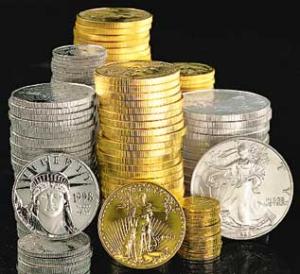

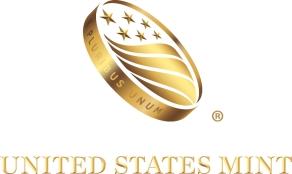
Minting Facilities
The headquarter of the US Mint is located in Washington, D.C. but no coins are produced there. The four minting facilities that together produce all the coinage are located in Philadelphia (P mint mark), Denver (D mint mark), San Francisco (S mint mark) and West Point, NY (W mint mark). The West Point branch of the US Mint is where the American Eagle coins out of gold, silver and platinum are minted. The engraving and design departments of the US Mint are located in Philadelphia. That is also where all master dies for the US coin production are made. However, working dies for all the mints are made in Denver. The US Mint also owns and runs the United States Bullion Depository in Fort Knox, Kentucky where all the country's precious metal bullion reserves are stored.
Some of the US Mint's historic pre-1933 gold coins were minted at branch mints that are no longer operational. These were the branch mints at Dahlonega (D mint mark), Charlotte (C mint mark), New Orleans (O mint mark) and Carson City (CC mint mark). The mint in Dahlonega was never in operation at the same time as the mint in Denver, so there can be no confusion even though both mints have the mint mark D.
Official US Mint branches were also once operational in Washington, D.C. and in Manila (M mint mark) in the Philippines. These branches did not mint any of the pre-1933 US gold coins though.
History
The first mint of the United States went into operation in 1793 in Philadelphia, then the US capital. At that time, various foreign gold and silver coins still circulated freely within America. Instead of being relocated to Washington D.C. in 1800 when the new capital was ready, the mint remained in Philadelphia due to the inability of the US government to finance the costly move of operation. In 1828, congress voted to have the mint remain in Philadelphia in perpetuity.
However, the first mint ran out of space and reached its production capacity limit by the late 1820's. The second mint opened in 1833 and produced coinage until 1901, when the third mint in the style of a Roman temple (now the Community College of Philadelphia) replaced it. The current 4th building of the US Mint in Philadelphia began operations in 1969.
The San Francisco branch of the US Mint had opened in 1854 during the California Gold Rush, the Denver branch in 1906 and the West Point branch only gained official status as a branch mint in 1988. In the past, the US Mint also had branch mints in Carson City (Nevada), Charlotte (North Carolina), Dahlonega (Georgia), New Orleans (Louisiana), Washington D.C. and Manila (Philippines) that are no longer in operation.
The US Mint's Gold Bullion Coins
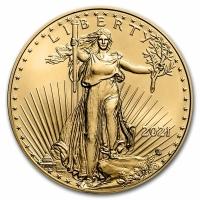
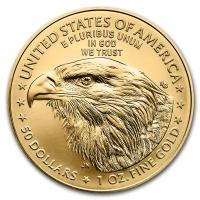
American Gold Eagles
The US Mint produces American Gold Eagle coins since 1986 with an obverse design that depicts Lady Liberty with flowing hair, holding a torch in her right hand and an olive branch in her left. This design is reminiscent of the historic Saint-Gaudens Gold Double Eagles. In 2021, a new reverse side design was introduced and some minor changes were made to the obverse side of the coins as well. The 91.67% pure gold coins exist with brilliant uncirculated, proof and burnished (only between 2006 and 2008) finishes. Four denominations of 1 oz, 1/2 oz, 1/4 oz and 1/10 oz are available. American Eagle coins count among the most popular gold coins. By law, the gold that is used to mint these coins must have been mined in the United States.
The American Gold Eagle page gives more information about the coins and allows you to compare current prices.
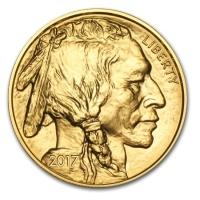
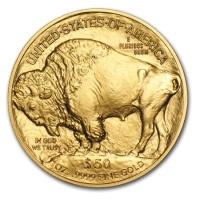
American Gold Buffaloes
The US Mint also produces the American Gold Buffalo coins. They were introduced in 2006 as the first and only 99.99% pure American gold bullion coins. Coins of that purity (24 karat) dominate the world's gold coin market with an annual share of sales of about 60%. The American Buffalo coins that borrow their design from the Indian Head nickel are currently issued in the single denomination of 1 oz with brilliant uncirculated and proof finishes. Fractional Gold Buffalo coins in the denominations of 1/2 oz, 1/4 oz and 1/10 oz were only issued in 2008, also as burnished coins. A special reverse proof version of the 1 oz Gold Buffaloes was only offered in 2013.
The American Gold Buffalo page gives more information about the coins and allows you to compare current prices.
The US Mint's Pre-1933 Gold Coins
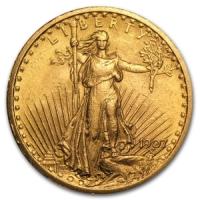
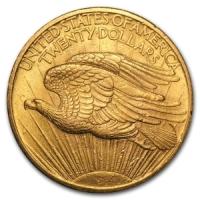
Saint-Gaudens Gold Double Eagles
The name of these coins refers to the US Mint sculptor Augustus Saint-Gaudens who designed them. The $20 Saint-Gaudens Gold Double Eagles succeeded the $20 Liberty Gold Double Eagles in 1907. The coins depict Lady Liberty on the obverse and a flying eagle with the sun on the reverse. The US Mint produced the new coins from 1907 to 1916 and then again from 1920 to 1933. The coins were struck at the US Mint facilities in Philadelphia, San Francisco and Denver. Their composition is 90% gold and 10% copper with each coin containing 0.9675 oz of gold. More than 70 million Saint-Gaudens Double Eagle coins were minted.
The Saint-Gaudens Gold Double Eagle page gives more information about the coins and allows you to compare current prices.
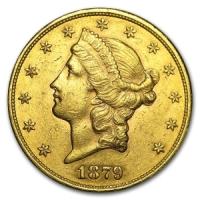
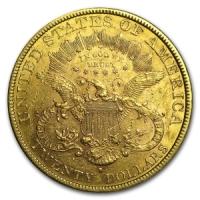
Liberty Gold Double Eagles
The $20 Liberty Gold Double Eagles were the predecessors of the $20 Saint-Gaudens Gold Double Eagles. The US Mint produced the coins from 1849 to 1907. They were struck at the US Mint facilities in Philadelphia, New Orleans, San Francisco, Carson City and Denver. Their composition is 90% gold and 10% copper with each coin containing 0.9675 oz of gold. Almost 104 million Liberty Double Eagles were minted. The coins depict a leftward facing Lady Liberty in profile on the obverse and an eagle that is holding a shield on the reverse. Three main coin subtypes and several additional varieties (for example the coins with a modified Paquet reverse) exist.
The Liberty Gold Double Eagle page gives more information about the coins and allows you to compare current prices.
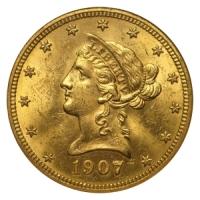
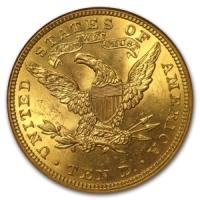
Liberty Gold Eagles
The $10 Liberty Gold Eagles were the predecessors of the $10 Indian Gold Eagles. The US Mint produced them from 1838 to 1907. The coins were struck at the US Mint facilities in Philadelphia, New Orleans, San Francisco, Carson City and Denver. They are composed of 90% gold and 10% copper with each coin containing 0.48375 oz of gold. Close to 43 million Liberty Eagle coins were minted. The design of the coins is the same as that of the bigger Double Eagles, depicting a leftward facing Lady Liberty in profile on the obverse and an eagle that is holding a shield on the reverse.
The Liberty Gold Eagle page gives more information about the coins and allows you to compare current prices.
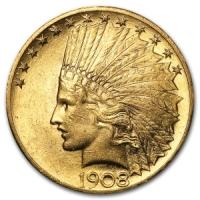
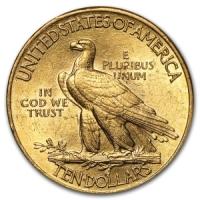
Indian Gold Eagles
The $10 Indian Gold Eagles succeeded the $10 Liberty Gold Eagles. The US Mint produced the new coins with years of interruption from 1907 to 1933. The coins were struck at the US Mint facilities in Philadelphia, San Francisco and Denver. They are composed of 90% gold and 10% copper with each coin containing 0.48375 oz of gold. Close to 15 million Indian Head Gold Eagles were minted. However, only a tiny amount were minted in proof condition at the Philadelphia facility. The coins depict a leftward facing Lady Liberty wearing a Native American headdress on the obverse and an eagle standing on a bundle of arrows with an olive branch on the reverse.
The Indian Gold Eagle page gives more information about the coins and allows you to compare current prices.
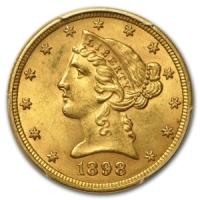
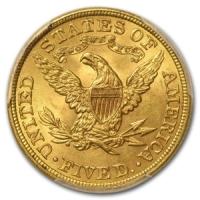
Liberty Gold Half Eagles
The $5 Liberty Gold Half Eagles were the predecessors of the $5 Indian Gold Half Eagles. The US Mint produced them from 1839 to 1908. The coins were struck at the US Mint facilities in Philadelphia, New Orleans, San Francisco, Carson City, Charlotte, Dahlonega and Denver, making them the only US coins that were produced at 7 different mint facilities. Their composition is 90% gold and 10% copper with each coin containing 0.24187 oz of gold. Close to 61 million Liberty Half Eagles were minted. However, only a tiny amount were minted in proof condition at the Philadelphia facility. The obverse side of the coins depicts Lady Liberty in profile and an eagle holding a shield appears on the reverse.
The Liberty Gold Half Eagle page gives more information about the coins and allows you to compare current prices.
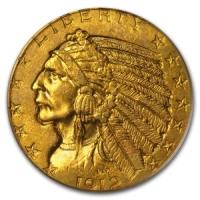
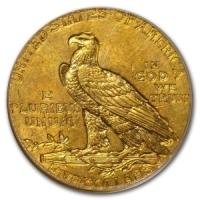
Indian Gold Half Eagles
The Indian Half Eagles succeeded the Liberty Half Eagles in 1908. The US Mint produced the $5 Indian Gold Half Eagles with years of interruption from 1908 to 1929. The coins were struck at the US Mint facilities in Philadelphia, San Francisco, New Orleans and Denver. They are composed of 90% gold and 10% copper with each coin containing 0.24187 oz of gold. About 14 million coins were minted. However, only a tiny amount were minted in proof condition at the Philadelphia facility. The obverse side of the coins shows a Native American Indian Chief wearing a traditional headdress and an eagle standing on a bundle of arrows and an olive branch is depicted on the reverse.
The Indian Gold Half Eagle page gives more information about the coins and allows you to compare current prices.
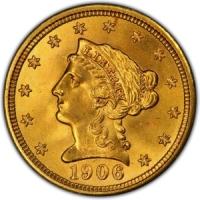
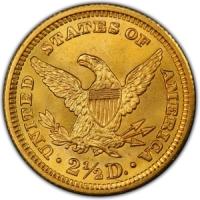
Liberty Gold Quarter Eagles
The $2.50 Liberty Gold Quarter Eagles were the predecessors of the $2.50 Indian Gold Quarter Eagles. The US Mint produced them from 1840 to 1907. The coins were struck at the US Mint facilities in Philadelphia, New Orleans, San Francisco, Charlotte and Dahlonega. Their composition is 90% gold and 10% copper with each coin containing 0.12094 oz of gold. Close to 12 million Liberty Quarter Eagles were minted. However, only a tiny amount were minted in proof condition at the Philadelphia facility. Lady Liberty is shown in profile on the obverse side of the coins and an eagle that is holding a shield can be seen on the reverse.
The Liberty Gold Quarter Eagle page gives more information about the coins and allows you to compare current prices.
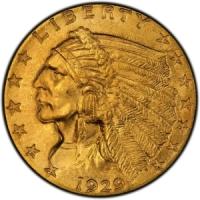
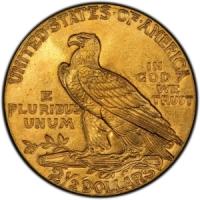
Indian Gold Quarter Eagles
The $2.50 Indian Gold Quarter Eagles succeeded the $2.50 Liberty Gold Quarter Eagles in 1908. The US Mint produced them with a period of interruption from 1908 to 1929. The coins were struck at the US Mint facilities in Philadelphia and Denver. Their composition is 90% gold and 10% copper with each coin containing 0.12094 oz of gold. More than 7 million Indian Quarter Eagles were minted. However, only a small amount were minted in proof condition at the Philadelphia facility. The obverse of the coins shows a Native American Indian Chief wearing a traditional headdress. An eagle that is standing on a bundle of arrows and an olive branch can be seen on the reverse.
The Indian Gold Quarter Eagle page gives more information about the coins and allows you to compare current prices.
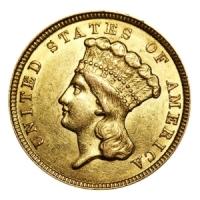
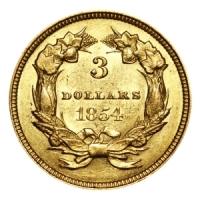
3 Dollar Indian Gold Coins
The US Mint produced the 3 Dollar Indian gold coins between 1854 and 1889. The coins are basically identical in design to the Indian Head Gold Dollars, depicting Lady Liberty with a Native American headdress on the obverse and an agricultural wreath of corn, cotton, wheat and tobacco on the reverse. Production of the coins was done at the US Mint facilities in Philadelphia, New Orleans, San Francisco and Dahlonega. They are made out of 90% gold and 10% copper and each coin contains 0.14512 oz of gold. According to the 1934 annual report of the US Mint, a total of 539,792 such Three-Dollar gold pieces had been produced. However, these coins are extremely rare nowadays.
The page for the 3 Dollar Indian gold coins gives more information about these rare coins.
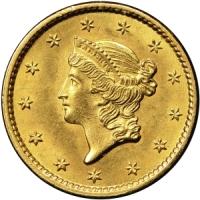
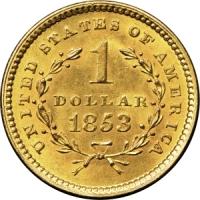
Liberty Gold Dollars
The $1 Liberty Gold Dollars were the predecessors of the $1 Indian Head Gold Dollars. The US Mint produced them from 1849 to 1854. The coins were struck at the US Mint facilities in Philadelphia, New Orleans, San Francisco, Charlotte and Dahlonega. Their composition is 90% gold and 10% copper with each coin containing 0.04837 oz of gold. About 12.6 million Liberty Head Gold Dollars were minted. A total of only 7 proof coins are believed to have been minted in 1849. No additional proof coins were minted in the following years. A profile of Lady Liberty appears on the obverse and a laurel wreath that is tied with a bow can be seen on the reverse.
The Liberty Gold Dollar page gives more information about the coins and allows you to compare current prices.
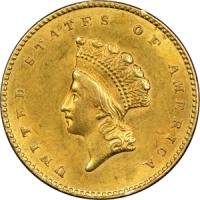
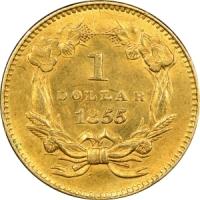
Indian Head Gold Dollars
The $1 Indian Head Gold Dollars succeeded the $1 Liberty Gold Dollars in 1854. The US Mint produced the new coins from 1854 to 1889. Two types of the coin exist that distinguish themselves by the size of the portrait on the obverse side. The coins were struck at the US Mint facilities in Philadelphia, New Orleans, San Francisco, Charlotte and Dahlonega. Their composition is 90% gold and 10% copper with each coin containing 0.04837 oz of gold. The coins' obverse shows Lady Liberty wearing a Native American headdress. Almost 7 million Indian Princess Gold Dollars were minted. An agricultural wreath of corn, cotton, wheat and tobacco that is tied with a bow can be seen on the reverse.
The Indian Gold Dollar page gives more information about the coins and allows you to compare current prices.
Other Precious Metal Bullion Coins


American Silver Eagles
The US Mint started with the production of American Silver Eagle coins in 1986. The coins are minted out of 99.9% fine silver and are offered with brilliant uncirculated, proof (no proof coins in 2009) and burnished uncirculated (2006 - 2008 and since 2011) finishes. Whereas the gold version of the coins is minted in four different denominations, Silver Eagles exist only as 1 oz coins. Another unusual feature for bullion coins is that the silver coins bear a totally different design (on both sides!) than their gold counterparts. The obverse side of the coins uses Adolph A. Weinman's famous "Walking Liberty" design that depicts Lady Liberty in stride towards the rising sun. In 2021, a new reverse side design was introduced and some minor changes were made to the obverse side of the coins as well.
The American Silver Eagle page gives more information about the coins and allows you to compare current prices.


American Platinum Eagles
The US Mint produces the American Platinum Eagles since 1997. The 1 oz coins with a US $ 100 face value are minted out of 99.95% fine platinum. Additional fractional coins were minted until 2008 in the sizes of 1/2 oz (US $ 50), 1/4 oz (US $ 25) and 1/10 oz (US $ 10). Buyers can choose between brilliant uncirculated, proof and burnished uncirculated (only from 2006 - 2008) coins with the latter two bearing the mint mark W for the West Point branch of the US Mint. Lady Liberty is portrayed in close-up on the obverse side of the American Platinum Eagle coins and an eagle in flight is shown on the reverse. However, the design of proof coins differs from this standard design in most years. Burnished uncirculated coins displayed the same design as the proof coins of the same year.
The American Platinum Eagle page gives more information about the coins and allows you to compare current prices.


Palladium American Eagles
The Palladium American Eagles are the US Mint's latest addition to the American Eagle bullion coin series. The first 15,000 brilliant uncirculated coins were issued on the 25th of September 2017. Proof coins were then released in 2018, followed by reverse proof coins in 2019 and burnished coins in 2020. In 2021, the US Mint released two versions of the Palladium Eagle coins in the same year, a proof version AND a brilliant uncirculated bullion version. All American Palladium Eagles are minted out of 99.95% fine palladium in the single size of 1 oz (US $ 25 face value). A young Lady Liberty wearing a winged Phrygian cap is depicted on the obverse side of the coins. The reverse shows an eagle perched upon a rock and holding an olive branch in its beak. The high-relief design of both sides was originally created by Adolph A. Weinman, one of the most famous American coin designers.
The American Palladium Eagle page gives more information about the coins.